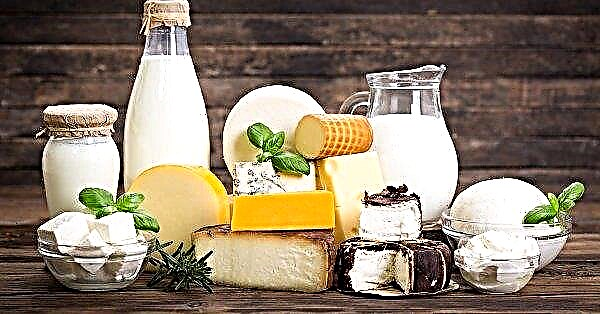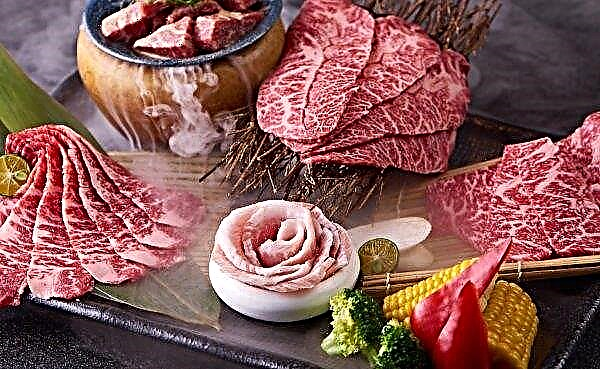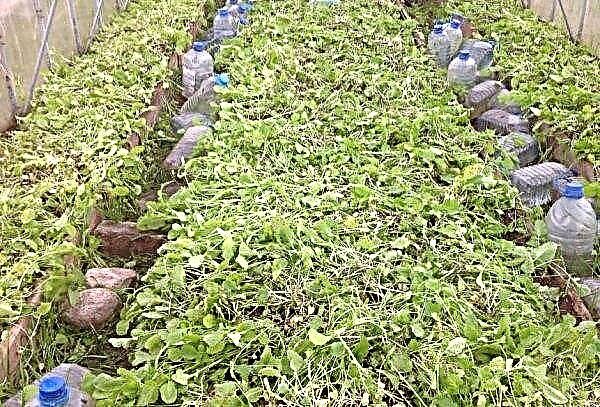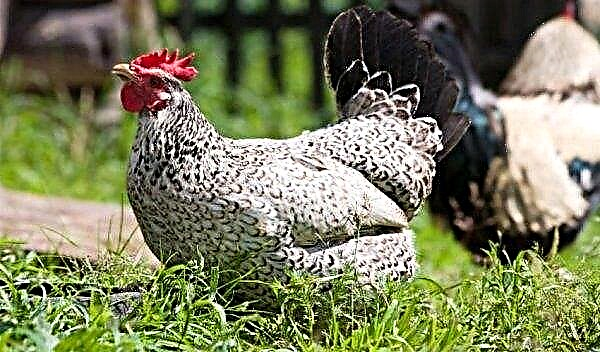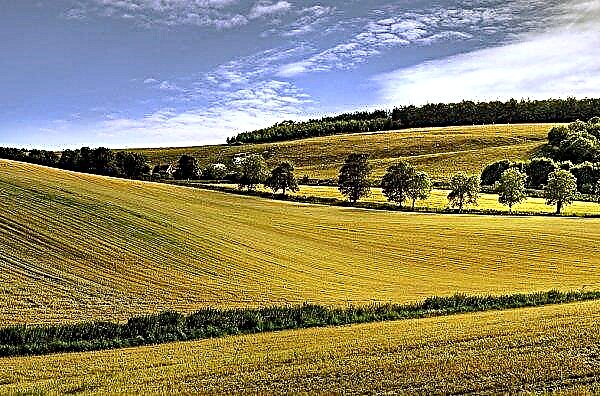Not all gardeners perceive the problem of yellowing of cucumber leaves as a violation of the growth and development of the culture, therefore they often do not pay due attention to this. In fact, the causes of this phenomenon can be serious and even dangerous. How yellowing seedlings of cucumbers in the greenhouse and after planting on the site, as well as how to protect young plants from this problem - read on.
The reasons why cucumber seedlings turn yellow
Analyzing the problem of yellow and drying leaves of cucumbers, it is worth considering several possible explanations at once. First, make sure that there is sufficient illumination of young seedlings, the optimal amount of fertilizer applied, regular irrigation, and no signs of disease or pest activity.
Lack of minerals or excess nitrogen
The basis for nutrient deficiency is the continuous cultivation of the crop in the same place without fertilizing the soil. The composition of the substrate under such conditions quickly becomes poorer, which is manifested in the yellowing of the edges of the leaves of seedlings, followed by complete drying of the entire leaf plate.
Depending on the lack of a particular element, several main symptoms of deficiency are distinguished, with the characteristic features of yellowing itself:
- veins turn yellow and dry along the edge of the leaf - the culture lacks magnesium;
- green veins are clearly visible on a completely yellow leaf - cucumbers need additional manganese;
- leaves discolor and slow down growth - you need to replenish calcium reserves;
- pallor and grinding of sheet plates indicates a lack of nitrogenous compounds in the soil;
- if the lightening of the leaves begins between the individual veins, and they do not change their color - think about the additional use of iron in top dressing.

Not only a limited amount, but also excessive intake of nutrients in the plant can cause yellowing of the leaf plates of cucumbers. For example, dried, light yellow plates around the edges indicate an excess of potassium (especially if their growth slows down), and the yellowing between the veins with further fading is the result of an excess of phosphorus.
Toxin Poisoning
Poisoning of seedlings with toxins is possible in case of violation of the requirements for its placement during cultivation, in particular when selecting seedlings. When heated in the sun, low-quality materials (for example, low-quality foam rubber or foam) emit chemically hazardous compounds that are absorbed by the surface of the sheets, causing their condition to deteriorate and yellow. It is difficult to predict the nature of the color change, because it can touch only one side of the sheet, or extend to the entire sheet plate, leaving only the edges green.
Did you know? On the territory of modern Russia, they learned about cucumbers in the 16th century, when the German ambassador Herberstein in 1528 noted them in his notes on a trip to Muscovy.
Non-compliance with temperature conditions
For seedlings, heat is an important condition for growth and development. At lower temperatures on the surface of the plant, the development of necrosis is possible - those same yellow spots. As soon as you notice them, try to stabilize the temperature in the greenhouse so that in the daytime the values reach + 19 ... + 25 ° C, and at night do not fall below + 16 ... + 19 ° C. In the future, with active fruiting of the culture, the nightly rates should be increased to + 19 ... + 21 ° C. To lower the temperature in a greenhouse, you can regularly open doors and windows, but without allowing cold drafts. Accordingly, in order to maintain high values, airing should only be done in the daytime, when the street temperature reaches its maximum.
To lower the temperature in a greenhouse, you can regularly open doors and windows, but without allowing cold drafts. Accordingly, in order to maintain high values, airing should only be done in the daytime, when the street temperature reaches its maximum.
Irrigation technique
When growing cucumbers, both humidification and a limited amount of moisture in the soil are equally dangerous, so with moderate rainfall in summer, the optimal regularity of watering is considered 3 times in 7 days, and in very hot weather the number of procedures is adjusted to 1 time in 2 days. From a lack of water, the plant quickly loses the accumulated moisture, which contributes to the appearance of dried yellow spots. Excessive amount of liquid threatens to rot the root system of cucumbers, which violates the development of aboveground parts with their further drying.
Lack of lighting
A shortage of sunlight contributes to the yellowing of only the lower leaf plates with the further death of individual sections. This phenomenon can be explained by the massive upper part of the bush, which covers the lower tiers and leads to their gradual death. To prevent or get rid of the problem, it is necessary to remove fading leaves in timeotherwise, they will take oxygen and part of the beneficial substances from healthy specimens, and close them from sunlight. A shortage of sunlight contributes to the yellowing of only the lower leaf plates with the further death of individual sections.
A shortage of sunlight contributes to the yellowing of only the lower leaf plates with the further death of individual sections.
Sometimes white-yellow spots on cucumber leaves indicate the last sunburn, due to the ingress of irrigation fluid onto their surface. To eliminate such a problem, it is worth pouring water exclusively under the root, and when growing in greenhouse conditions, monitor the absence of condensate on the surface of the culture. In most cases, following these recommendations, no problems will arise in the future.
Important! When growing cucumbers in too open areas, at the peak of solar activity, it is worth shading young seedlings, using cardboard or a dense dark film for this, which will limit the penetration of light.
Disease
Plant damage can also be affected by fungal infections, which are often accompanied by the formation of rust spots on the surface, causing gradual wilting of plants.
The reason for the development of ailments often becomes a sharp change in weather conditions and non-compliance with crop rotation rules on the site, and as for the type of possible diseases, the most common are:
- powdery mildew, manifested in the form of a white-gray coating on the outside of the leaves (if the problem is not timely eliminated, the leaf plates of cucumbers quickly turn yellow and curl);

- anthracnose - It is manifested by clearly visible yellow-brown spots, which contribute to curling and complete drying of the leaf.
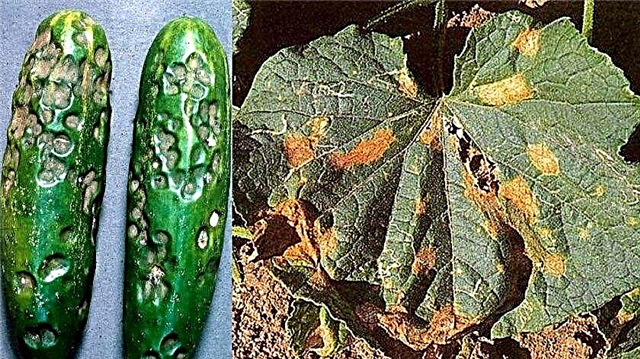
In the fight against diseases, fungicidal preparations are used, the most famous of which are “HOM” and Bordeaux mixture.
Pests
Most harmful insects that live on cucumber bushes feed on the juice of leaves and other parts of the culture. The tissues damaged by them quickly die off, which is externally manifested by yellowness. With a massive invasion of a spider mite, aphid or whitefly and the absence of an adequate elimination of the problem, not only individual leaves, but also the cucumber bush itself can die.  You can detect insects with the naked eye, during the next inspection of the plantings: aphid accumulation is noted on the inside of the leaf, and the spider mite leaves a thin web in such places. In this case, nitroammophoska and a solution of colloidal sulfur, with several repetitions of treatments, are often used to treat plants.
You can detect insects with the naked eye, during the next inspection of the plantings: aphid accumulation is noted on the inside of the leaf, and the spider mite leaves a thin web in such places. In this case, nitroammophoska and a solution of colloidal sulfur, with several repetitions of treatments, are often used to treat plants.
What to do if seedlings turn yellow?
In case of yellowing of cotyledon leaves on cultivated seedlings of cucumbersIt is worth revising the features of the care of the plantings. Perhaps the reason is hidden in the formation of new shoots, which means that to normalize the state of culture, it is enough to remove the extra ovaries and twigs.
In the case when the cause of the color change of the sheet plates is a violation of agricultural technology, make a calendar of the main activities for plant care, watering, cultivating, fertilizing and mulching only in accordance with it. In most cases, some time after the regular execution of all procedures in accordance with the new schedule, there will be no further spread of yellowness, and existing yellow spots will become less noticeable.
If the cause of the described problem is a violation of the temperature conditions, try not to lower the values anymore and protect young seedlings from such changes. When growing cucumbers in the open field in early spring, it is worthwhile to cover the beds with special material (for example, agrofibre or ordinary polyethylene) so that in case of possible return frosts, fragile seedlings do not suffer .
Sometimes leaves on seedlings turn yellow only on a separate side of the bed, which is most likely due to the wrong place to grow it.: depleted soil or lack of sunlight. Probably, you will not be able to eliminate this problem, unless you try to transplant plants.
Important! In the middle lane, sowing of cucumbers with seeds in open ground is performed no earlier than the third decade of May, and in the southern regions these dates are shifted to the second half of April, the main thing is that the soil warms up to + 12 ° C.
How to protect leaves from yellowing?
To prevent yellowing of leaves on seedlings, it is important to adhere to the rules for its cultivation:
- The annual change in the place of organization of cucumber beds, and with the choice of a site away from the places of growing pumpkins or zucchini (considered undesirable crop predecessors).
- Compliance with the requirements for watering cucumber bushes, avoiding either overflows or excessive drying of the substrate (in extreme cases, in order to maintain optimal humidity, you can always mulch the bed with grass or sawdust).
- To maintain normal levels of nutrients in the soil, it is worth regularly using nutrient mixtures, introducing them into the ground mainly in liquid form.
- At the stage of forming 3-4 leaves, cucumbers can be sprayed with a prophylactic composition prepared from a liter of milk, iodine (20 drops) and laundry soap (20 g), diluted in a bucket of clean water (treatment with this mixture can be performed on a regular basis, but with a frequency of 1 every 10 days).
 To prevent fungal ailments, at the beginning of summer the plant is treated with soda var, dissolving 1 tbsp. spoon of soda in 10 liters of water. The prepared liquid is poured under the root of the cucumber bushes.
To prevent fungal ailments, at the beginning of summer the plant is treated with soda var, dissolving 1 tbsp. spoon of soda in 10 liters of water. The prepared liquid is poured under the root of the cucumber bushes.It is also possible prophylactic spraying with special fungicidal and insecticidal drugs. If you want to harvest an environmentally friendly crop, then it is better to use folk recipes.
Useful tips gardeners
It is possible to exclude the appearance of yellowness on the leaves of sown cucumber seedlings even at the stage of caring for young seedlings, shading them from direct sunlight, regularly watering and airing.
However, this is not all the recommendations regarding the cultivation of cucumbers, and it is worth paying attention to the following tips:- Make sure that the plants are not too crowded in seedlings, if necessary, culling the weakest specimens (they are removed in the cotyledon phase and at the stage of formation of the first true leaves).
- When planting late in the greenhouse shelter, monitor the larger feeding area when placing seedlings so that each seedling receives a sufficient amount of nutrients.
- Transplanting seedlings to the site is possible only when young cucumbers reach the age of 20–25 days, which in the future will provide easy adaptation in a new place.
- If yellow spots were already observed on the leaves, and the reason for their appearance was an overflow during watering, it is worth temporarily stopping the introduction of liquid and after the substrate has completely dried, pour the plants with an ash solution.
- It is desirable to use plant nutrient infusions for top dressing in exceptional cases and only with confidence that there are no spores of pathogenic microorganisms.
Otherwise, the care of cucumbers is based on the same actions as growing other garden crops, so if the seedlings still do not grow (or grow poorly) and their leaves turn yellow, it is worth revising the plan for all agricultural activities.




